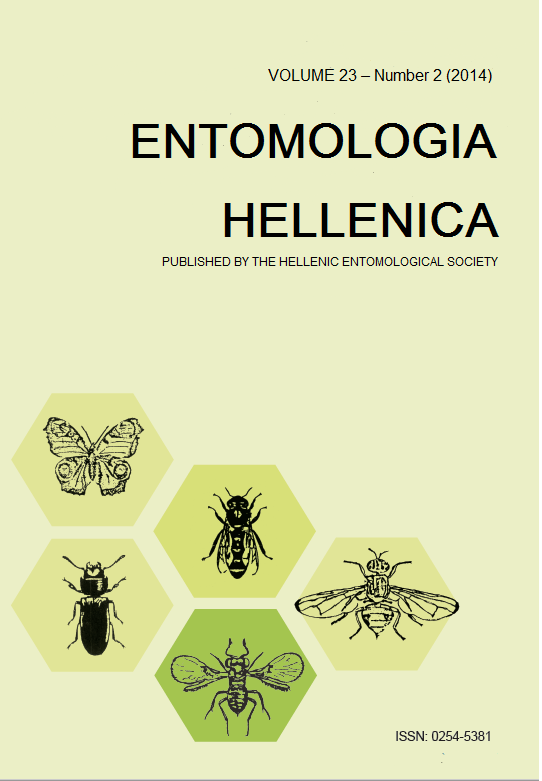Μελέτη επί της συνδυασμένης δράσης του εντομοπαθογόνου βακτηρίου Bacillus thuringiensis subsp. kurstaki και του εντομοπαθογόνου νηματώδη Heterorhabditis bacteriophora
Περίληψη
Στην παρούσα εργασία μελετήθηκε η συνδυασμένη δράση του εντομοπαθογόνου βακτηρίου Bacillus thuringiensis subsp. kurstaki (B.t.k.) και του εντομοπαθογόνου νηματώδη Heterorhabditis bacteriophora (Nematoda: Rhabditida) επί προνυμφών του λεπιδοπτέρου Ephestia kuehniella (Lepidoptera: Pyralidae) σε σπόρους σίτου. Στις δοκιμές χρησιμοποιήθηκαν ομάδες 10 προνυμφών 4ης προνυμφικής ηλικίας, τοποθετημένες σε τρυβλία Petri που περιείχαν 10g αποστειρωμένων σπόρων σίτου, τα οποία είχαν προηγουμένως ψεκαστεί με υδατικό διάλυμα βακίλου στις συγκεντρώσεις 500ppm, 1000ppm και 3000ppm. Εν συνεχεία, οι προνύμφες λούζονταν με 1ml υδατικού διαλύματος νηματωδών (1000IJs/ml), τα τρυβλία κλείνονταν καλά με υδατοστεγή ταινία και τοποθετούνταν σε θάλαμο ελεγχόμενων συνθηκών (25οC, 80% Σ.Υ.). Η αλληλεπίδραση των εντομοπαθογόνων παραγόντων υπολογίστηκε με την βοήθεια του διωνύμου Robertson και Preisler και η αποτελεσματικότητα κάθε παθογόνου παράγοντα με τον τύπο του Abbott μετά το πέρας του πειράματος. Από τα αποτελέσματα διαπιστώθηκε ότι η χρήση και των δύο παθογόνων παραγόντων προκάλεσε υψηλή θνησιμότητα στις προνύμφες του εντόμου E. kuehniella. Οι θνησιμότητες που προέκυψαν μετά από 28 ημέρες ήταν για τον B.t.k. 500ppm: 20%, για τον B.t.k 1500ppm: 25%, για τον B.t.k 3000ppm: 40%, για τον νηματώδη 1000IJs/ml: 27% και για τους συνδυαστικούς χειρισμούς B.t.k 500ppm + νηματώδη 1000IJs/ml: 85%, για το B.t.k 1500ppm + νηματώδη 1000IJs/ml: 40%, για το B.t.k 3000ppm + νηματώδη 1000IJs/ml: 50%, ενώ για τους μάρτυρες (χειρισμός με H20): 7%. Αξιοσημείωτη είναι τόσο η υψηλή δραστικότητα του συνδυασμού.
Λεπτομέρειες άρθρου
- Πώς να δημιουργήσετε Αναφορές
-
Zampara, I., Zamparas, C., Mantzoukas, S., & Karanastasi, E. (2014). Μελέτη επί της συνδυασμένης δράσης του εντομοπαθογόνου βακτηρίου Bacillus thuringiensis subsp. kurstaki και του εντομοπαθογόνου νηματώδη Heterorhabditis bacteriophora. ENTOMOLOGIA HELLENICA, 23(2), 74–86. https://doi.org/10.12681/eh.11539
- Τεύχος
- Τόμ. 23 Αρ. 2 (2014)
- Ενότητα
- Articles

Αυτή η εργασία είναι αδειοδοτημένη υπό το CC Αναφορά Δημιουργού – Μη Εμπορική Χρήση – Παρόμοια Διανομή 4.0.
Authors who publish with this journal agree to the following terms:
Authors retain copyright and grant the journal right of first publication with the work simultaneously licensed under a Creative Commons 4.0 license.
Authors are able to enter into separate, additional contractual arrangements for the non-exclusive distribution of the journal's published version of the work (e.g. post it to an institutional repository or publish it in a book), with an acknowledgement of its initial publication in this journal. Authors are permitted and encouraged to post their work online (preferably in institutional repositories or on their website) prior to and during the submission process, as it can lead to productive exchanges, as well as earlier and greater citation of published work.



